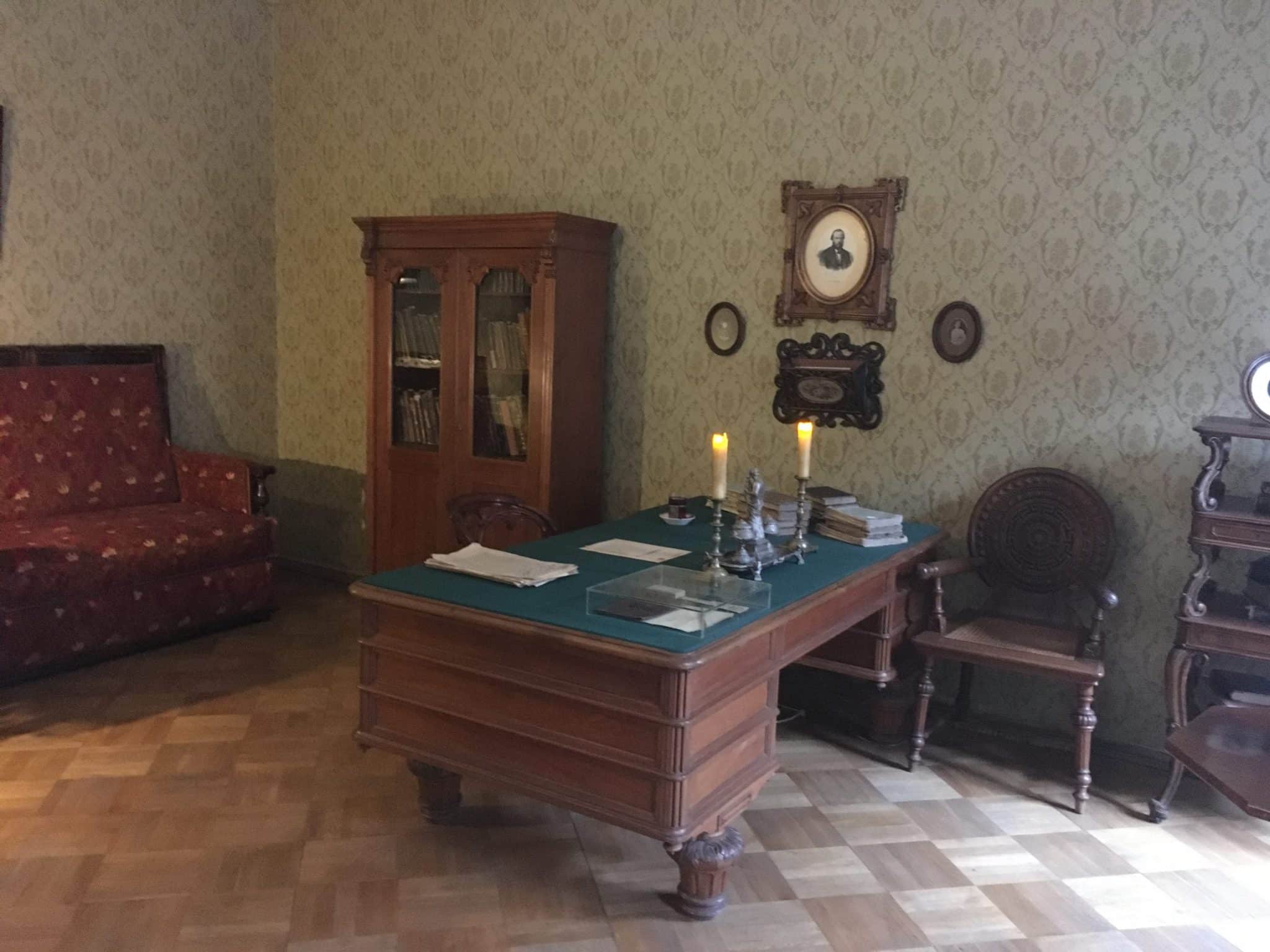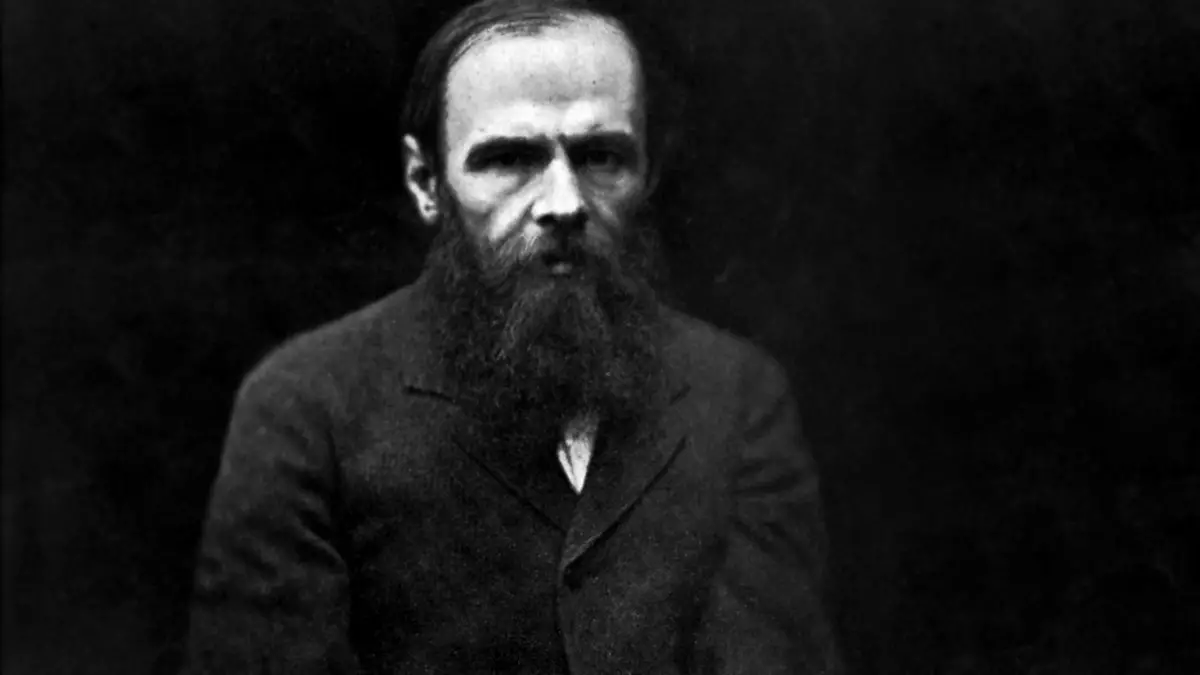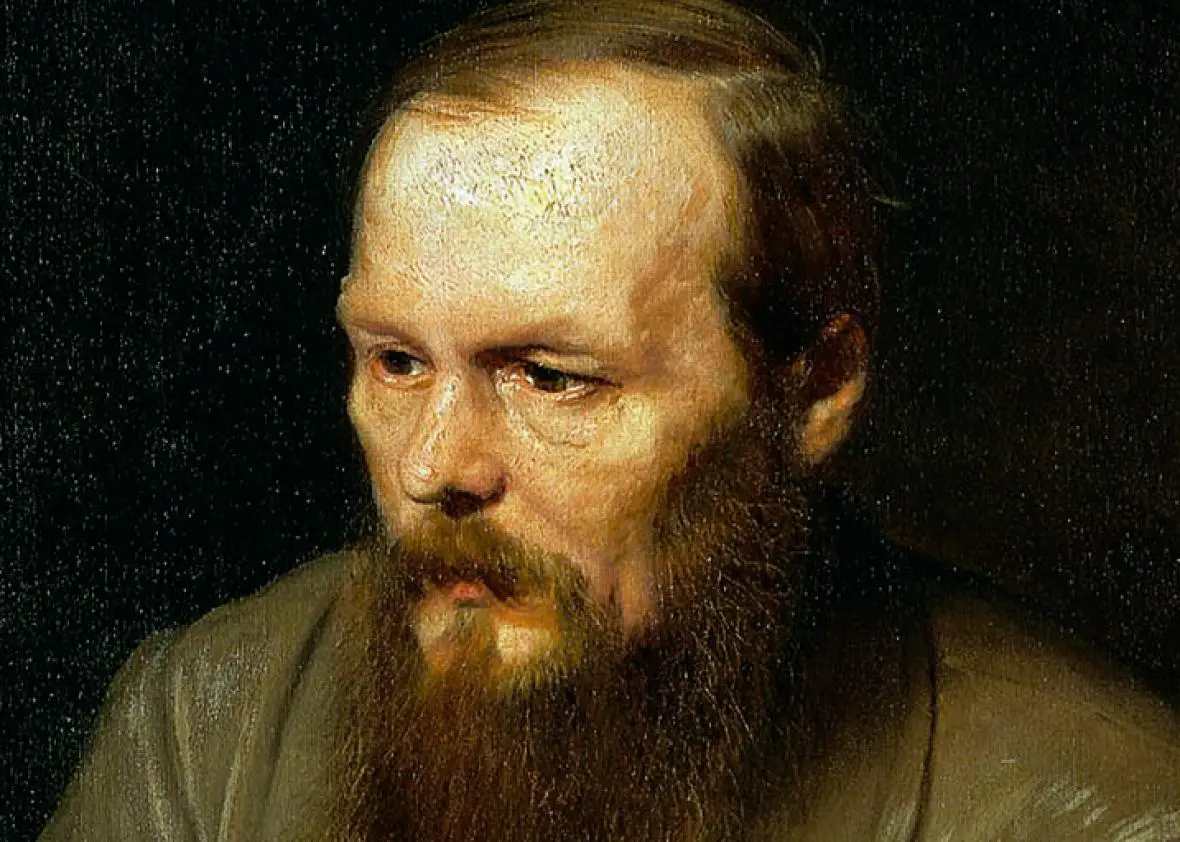Few symbols in literature are more evocative than blood. Its presence can conjure up fear, anger, sadness, confusion, and a host of other emotions in a reader. Blood seems to have a hold on the human psyche that is very nearly universal. Dostoevsky was no stranger to this concept. His novel Crime and Punishment makes frequent and graphic use of blood to convey his ideas. To him blood is a sign and means of initiation. Often he uses blood to evoke the image of the Orthodox sacrament of the Holy Eucharist. This holds special significance for Raskolnikov, who is at first symbolically initiated into evil and is then symbolically initiated into suffering and redemption. Dostoevsky uses this symbolism and imagery to support major themes and undertones of the novel.
Blood has been used in initiation rites throughout recorded history. It can be seen in accounts of ancient religious initiations in such varying traditions as Greek mystery cults, Judaism, and African rights of passage. Foremost in Dostoevsky’s mind would have certainly been the Holy Eucharist of the Orthodox Church. In this rite, Orthodox Christians believe, bread and wine become the real, physical body and blood of Jesus Christ. The Orthodox Church teaches that in the Eucharist ceremony worshipers are initiated into Christ’s very being, becoming “partakers of divine nature” (Clendenin 26). It is such an important initiation rite that even infants participate directly following their baptisms (Clendenin 28).
While many Christian traditions have the Eucharist as a central initiation, there is an important distinction made in the Orthodox Church. While in the Catholic version of the rite and in others the Eucharist cup is reserved for the clergy, in the Orthodox Church all believers partake of the Holy wine. To the Orthodox believer there is a very real sense in which each and every person who receives the sacrament partakes of the blood of Christ. This blood serves to transport the worshiper into the “union of Christ” (Clendenin 26), and Christ in a mystical way lives in him or her.
This dogma was most certainly in Dostoevsky’s mind when he wrote Crime and Punishment. Raised in the Russian Orthodox Church, he would have become used to receiving Eucharist wine as the blood of Christ from very early on in life. The connection in his mind between blood and wine is seen clearly in Crime and Punishment, where blood is “spilt like champagne” (Dostoevsky 423). It is interesting to note that blood seems to cause Raskolnikov to act in a drunken manner. After incidences such as the old woman’s murder he wanders, loses his powers of reason, and often forgets where he has been.
Raskolnikov goes through a series of initiations by blood. The first of these initiations is the murder of Alyona Ivanovna and her sister Lizaveta. Raskolnikov first knows the old pawnbroker is dead by the blood from her head, which flows “as from an overturned glass” (Dostoevsky 63). This interesting description of the bleeding is the first sign of Eucharist imagery. At first Raskolnikov tries not to get any of the blood on himself. Soon, however, he is forced to, “smearing his hand” (Dostoevsky 63) as he robs the dead woman. As he does this he pulls, rather ironically, two crosses and an icon from her neck. These images would have certainly been present at the celebration of any sacrament. The entire scene serves to picture Raskolnikov as being at a sort of unholy Eucharist, being initiated, frighteningly, into Alyona Ivanovna.
Raskolnikov immediately begins to partake of the old woman’s nature. One of his first actions following Alyona’s murder is to kill her sister, Lizaveta. This is nothing more than the old woman’s manner of treating Lizaveta, taken to its final degree. The old woman has long regarded her sister’s life as being worthless. Now Raskolnikov has done the same. Throughout the rest of the novel, Raskolnikov scarcely seems to be aware that he has murdered Lizaveta. Frequently, when talking about his crime, he says that he has “killed…an old pawnbroker” (Dostoevsky 422), rarely even mentioning the second murder at all. He seems to be barely conscious that Lizaveta ever existed, and he certainly would not seem to attribute any importance to that existence.
Even as Christ is seen as being alive, though his blood is drunk, so Alyona is alive for Raskolnikov. In a dream Raskolnikov returns to the fateful room where the murders took place. Finding the old pawnbroker hiding in a corner, he once again swings his ax at her. This time, however, she cannot be killed. His attempts at murdering her again are so futile as to be humorous. As he strikes Alyona Ivanovna, she is “simply shaking with mirth” (Dostoevsky 225). The old pawnbroker woman within Raskolnikov cannot die! Though her blood has been shed, she is alive in Raskolnikov’s psyche.
This initiation by blood is first and foremost an initiation into evil. Raskolnikov is guilty of an evil from which he cannot find an escape. In reality he has murdered not only two women, but also any goodness which may have lived in him. “It was the devil that killed that old woman” he tells Sonia. “I murdered myself” (Dostoevsky 341). He has committed sin that needs expiation. His death is a spiritual one, and he looks to the story of Lazarus for hope of resurrection.
In the Orthodox tradition, some sacraments are repeatable and some are not (Clendenin 22). Raskolnikov has a chance at resurrection because the Eucharist is a repeatable sacrament. In the novel there is another cup of blood for him to drink from, another death which affects his course. After partaking of this blood he can eventually seek redemption. It will, however, send the murderer into profound suffering. It is, ironically, the blood of a pitiful drunk. Marmeladov’ death provides Raskolnikov’s second Eucharist.
Marmeladov’s death is horrifically bloody. He is utterly crushed by the carriage, having his face and chest horribly disfigured. Raskolnikov is at once immersed into Marmeladov’s blood. Having met him in a tavern, Raskolnikov is the only one of the crowd able to recognize the disgraced clerk. Rodion Romanovitch, with the help of the police, assists the dying man to his home. There, in the arms of his daughter Sonia, he passes from this life’s misery. The scene leaves Rodion “spattered with blood” (Dostoevsky 153). Dostoevsky leaves no mistake that he means for this to be a second Eucharist scene. Throughout the passage he uses the imagery of the holy sacrament. Blood is everywhere. That Marmeladov is a drunk is mentioned at every turn, bringing to mind the holy wine. Finally a priest is called in to hear Marmeladov’s final confession. This practically makes the little room where the family lives seem like the sanctuary of a church.
This second initiation by blood differs from the first in that Raskolnikov is not initiated into Marmeladov’s being, so much as he is initiated into his role. Rodion Romanovitch immediately steps in to provide for and protect the Marmeladov family. He gives Katerina Ivanovna a significant sum of money to provide for Marmeladov’s funeral. He protects Sonia from the false accusations of Luzhin. Raskolnikov seems to fill the place of father and husband for this destitute family. Rodion Romanovitch also eventually takes on Marmeladov’s role as a buffoon. At the very beginning of the novel Marmeladov is shown in a tavern making a fool of himself. He makes a drunken rant and confesses his sinfulness to the crowd, which enjoys mocking him. They make a point of deriding his drunken state. In one of the final scenes Raskolnikov makes his confession to a crowd. He bows low and kisses the earth in a rather ridiculous fashion. The onlookers accuse him of being drunk as well. He has completely imitated his initial meeting with Semyon Zaharovitch.
It is, significantly, through the death of Marmeladov that Raskolnikov first comes into contact with Sophia Semyonovna. She represents to him both joy and suffering. She calls Rodion both to repentance and resurrection. It is Sonia who tells Rodya to confess to the murder at the crossroads. It is Sonia who reads to him the story of the resurrection of Lazarus and offers him hope for his own return from the dead. Marmeladov’s blood initiates Raskolnikov into love for Sonia, which is his path to redemption. This path to redemption is one of great suffering. Marmeladov himself sought “tears and tribulation” (Dostoevsky 18) as his only hope. Raskolnikov must suffer for his crimes. Eventually he must turn himself in. Eight years of penal servitude in Siberia are his first steps to spiritual renewal.
This second initiation is sustained by the slow and painful death of Katerina Ivanovna. Katerina’s blood initiates Raskolnikov into a more specific kind of suffering. It is the suffering of the poor and destitute. She is not killed quickly as Marmeladov is. She is slowly eaten away by consumption, a malady often caused by living in poverty. Her blood comes gradually through her “terrible, hollow coughs” (Dostoevsky 152). She suffers more severely than anyone in the novel does. The religious character in the novel see this as something holy. When she showed him the blood she had coughed up, the priests reaction was that he “bowed his head and said nothing” (Dostoevsky 152), showing her blood great reverence. Sonia sacrifices her body to provide for Katerina Ivanovna. Her bloody suffering is a holy thing in the novel. The Orthodox faith sees the Eucharist as something that sustains the spiritual life of the believer (Clendenin 29). In the same way Katerina Ivanovna’s blood seems to sustain Rodya down the path of suffering. Each time he comes into contact with her, he is moved to sacrifice for her family. The first time he meets her, when he brings Semyon Zaharovitch home drunk, he leaves them money. When Marmeladov dies Rodion provides for the funeral. Katerina’s blood compels him to give to the poor. Using the Eucharist symbolism gives Dostoevsky a powerful image that would have resonated with his readers. They would have been intimately familiar with the idea of blood as initiation. The idea of the deaths leading to Raskolnikov partaking of different natures would have been easily understood and would have done much to help convey Dostoevsky’s ideas to his audience. In addition to this, the imagery does a great deal to support his other thematic concepts. These concepts in turn support the overall message of the novel.
First, the Eucharist imagery supports the major theme of the novel, which, as the title reveals, is crime and punishment. In Christian doctrine the crucifixion of Christ is a punishment for the transgressions of the world. The Eucharist is made possible by this atoning death. The Eucharist also pictures the shedding of Christ’s blood. The sacramental symbolism in the novel supports the idea that wrongdoing deserves punishment. Ultimately Raskolnikov’s crimes do bring about consequences. Taken together, the Eucharist images form a “Dostoevskian double” (Bloom 49). Dostoevsky often had images, characters, or settings deliberately parallel one another within the same work. This would serve to show the logical conclusions of an idea (Bloom 49). Another example of a “Dostoevskian double” in Crime and Punishment is the juxtaposition of Sonia and Dounia in Part 1. Dounia’s proposed marriage to Luzhin is an ideological precursor to Sonia’s prostitution. The first initiation by blood, the old woman’s murder, makes Raskolnikov guilty of bloodshed. Raskolnikov tries to excuse this guilt by saying that Alyona Ivanovna’s death was good for society. She is a “louse” and keeps others from attaining their goals. This idea, taken another step further, says that Marmeladov’s death is a good thing. Katerina Ivanovna even says this. If he hadn’t died she would have been “sousing and rinsing till daybreak” (Dostoevsky 151). His death has decreased her suffering and she is therefore justified at being happy about it. Here is the “Dostevskian double”.
The Eucharist imagery helps in that it calls to mind another death that was purportedly for the common good. Christians hold that Christ’s death greatly benefited them. By picturing the deaths of Alyona Ivanovna and Semyon Zaharovitch as being sacramental, Dostoevsky forces out the next logical questions of the idea: if the old pawn broker’s death and the demise of Marmeladov are beneficial, and Christ’s death was beneficial, what is the difference? Isn’t Raskolnikov even “righteous” in his killing? Isn’t Katerina Ivanovna “holier” because of her happiness? Dostoevsky leaves these questions unanswered. The use of blood as initiation also supports what Mikhail Bakhtin calls the “carnivalization” of the novel (Bloom 135). Bakhtin uses this term to compare the plot and setting of Crime and Punishment to the carnivals held in Medieval Europe. These festivals were times when normal social order did not apply. One could find all manner of absurd situations and people. Bakhtin supports the idea that Dostoevsky’s novels often exude the air of one of these carnivals. The images Dostoevsky uses create many of the absurdities Bakhtin writes about. Through the Eucharist image, Alyona Ivanovna’s blood becomes an absurd parody of Christ’s blood. A drunken man’s love for his prostitute daughter points the way to redemption for a depraved murderer. Anything goes at a carnival, when disorder is king. Dostoevsky is willing to make comparisons and allusions in a carnival setting that wouldn’t be allowed under normal circumstances. The deification aspect of the Eucharist, which imparts the nature of the subject whose blood is shed to the partaker of the blood, also creates absurdities. Raskolnikov, through initiation by blood, becomes things that he is not. Thus the impoverished law student becomes, in spirit, a greedy pawnbroker. A young intellectual takes an old, drunken buffoon’s place in a suffering family. These absurd situations are typical of what is meant by “carnivalization”.
Blood even serves to initiate the carnival atmosphere. As was stated previously, blood seems to send Raskolnikov into a drunken state. From then on the novel is filled with drunks, including Marmeladov, Razumihin, and others. Porfiry comes in from out of town and begins investigating the murders. His presence in the novel is owed entirely to blood. He is in every way the picture of a carnival jester. He laughs at almost everything he says. He jokes with Raskolnikov over very serious matters. He plays psychological games with the killer in order to force a confession. The carnival atmosphere of the novel, together with the idea of the double, serves major constructive purposes for the theme of the novel. They are greatly aided by the idea of initiation by blood. Many major events in the plot are brought about through initiation by blood. Most important, however, is the powerful imagery that initiation by blood gives. It conveys ideas, questions, and themes that are in fact central to the purpose of Crime and Punishment.
Works Cited
Bloom, Harold Ed. Crime and Punishment: Modern Critical Interpretations. First Edition, Chelsea House Publishers. New York, 1988.
Clendenin, Daniel B. Eastern Orthodox Theology: A Contemporary Reader. Second Edition, Baker Academic Publishers. June 2004.
Dostoevsky, Fyodor. Crime and Punishment. Barnes and Noble Books. New York, 1994.
You Might Also Like
(includes current article)

The Dostoevsky Memorial Apartment Museum in St. Petersburg
The Dostoevsky Memorial Apartment Museum at 5/2 Kuzneckny Pereulok in St. Petersburg is dedicated to drawing a picture of the great Russian writer as a person with a focus on his work habits, on his concerns, and particularly on his family life. Even discussion of his greatest novels is presented within the context of telling […]

Crime and Publishing: How Dostoevskii Changed the British Murder
A few words on this book: Described by the sixteenth-century English poet George Turbervile as “a people passing rude, to vices vile inclin’d,” the Russians waited some three centuries before their subsequent cultural achievements—in music, art and particularly literature—achieved widespread recognition in Britain. The essays in this stimulating collection attest to the scope and variety […]

The Hero of Cana: Alyosha’s Ode to Joy in The Brothers Karamazov
Dostoevsky’s The Brothers Karamazov opens with a particularly unsatisfying note. The fictional narrator declares in his “From the Author” that the hero of the book is Alexei Fyodorovich Karamazov. Quickly following this declaration is a confession: “To me he is noteworthy, but I decidedly doubt that I shall succeed in proving it to the reader” (Dostoevsky 3). […]

Suicide as a Final Reconciliation of Conflicting Identities in The Brothers Karamazov
The function of violent death is complex in Fyodor Dostoevsky’s The Brothers Karamazov: it serves as the driving focus of the work, calls into question the many characters’ agency and morality, and provides a forceful resolution. At the forefront of the novel is the murder of Fyodor Pavlovich by one of his sons. Parricide is the […]

Rational Perversions of Love in The Brothers Karamazov: Spiritually Fruitless, yet Thematically Useful
In The Brothers Karamazov, Fyodor Dostoevsky spends countless pages elucidating his ideal of love. Among his many characters, he offers complex portraits of two intriguing individuals, whose love does not quite fit his definition of this ideal. The Grand Inquisitor and, by extension, his creator Ivan, are often seen as simply hyper-rational characters who reject God’s […]
Or, find all Dostoevsky articles on this site.





